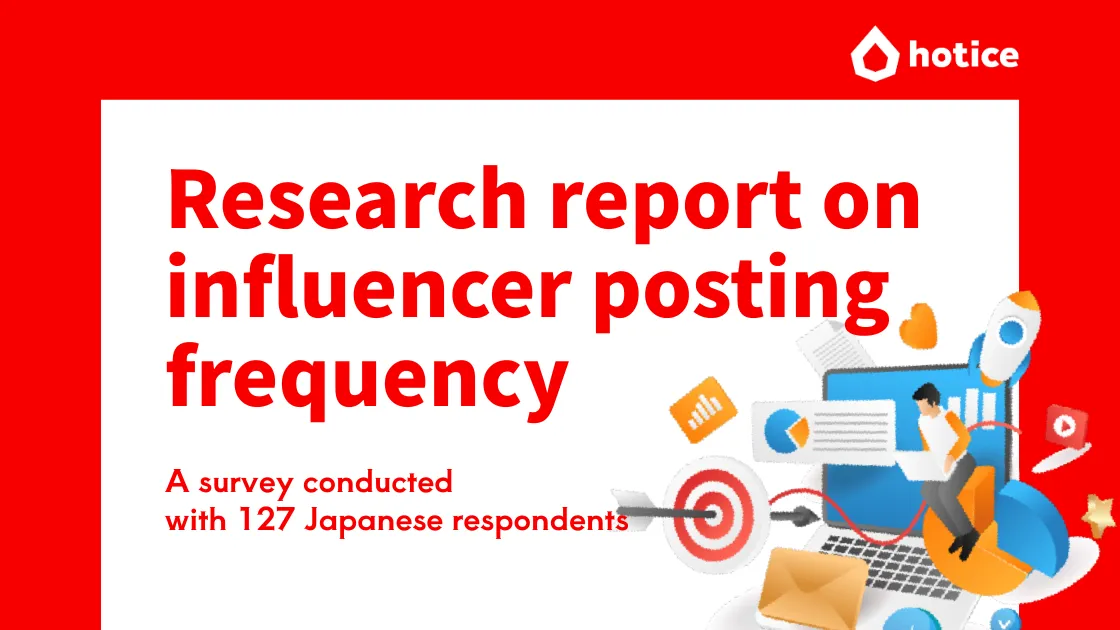What’s the “Right” Posting Frequency? Learning the Ideal Update Rhythm from Platform-Specific User Behavior

Should You Post Every Day—or Hold Back to Build Trust?
Are you struggling to find the right posting frequency for your social media strategy?
Post too often, and you risk coming across as pushy or overwhelming. Post too infrequently, and you might seem inactive or disconnected. On social media, even the timing between posts can significantly influence how trustworthy or likable your brand appears.
In reality, users are not only sensitive to what you post, but also how often you post it. For creators and brands operating with the visibility of influencers, posting rhythm can directly affect brand perception—and even purchasing behavior.
Even if we think we’re not paying attention to frequency, our subconscious may still be judging the reliability and intent behind a creator’s update tempo.
This report dives into data-driven insights about ideal vs. actual posting frequencies across major platforms, how users feel about different rhythms, and how those perceptions influence behavior.
By understanding these trends, you’ll learn how to design the right frequency for your content—not based on guesswork, but grounded in user psychology and platform-specific norms.
With a data-informed rhythm, your social media presence can become more natural, more consistent—and more impactful.
Is There a Gap Between Ideal and Actual Posting Frequency? A Platform-by-Platform Breakdown
Across social media platforms, there’s often a noticeable gap between how often users want to see posts—and how often they actually see them.
In this study, we analyzed user expectations and real-world posting habits across the following platforms:
- Instagram: 43 respondents
- TikTok: 28 respondents
- YouTube: 40 respondents
- X (formerly Twitter): 16 respondents
What we found is that striking the right balance is tricky across all platforms. Posting too often can feel overwhelming, while posting too little can lead to disengagement or even mistrust.
In this section, we dive into each platform’s unique dynamics and unpack how user psychology differs when it comes to posting frequency—revealing what “just right” really means for each channel.
Instagram: “Once a Day” Is Ideal—But Some Prefer a Lighter Touch

On Instagram, many users reported seeing posts at a frequency of “1–2 times per day” or even “3 or more times per day.” Interestingly, the most preferred posting frequency was also “1–2 times per day,” indicating that users are generally accustomed to frequent updates on the platform.
However, a notable portion of users said they felt “once every 2–3 days” or “1–2 times per week” was ideal. This suggests that while frequent posts are common, some users actually find less frequent updates more comfortable—perhaps due to the large number of accounts they follow and the volume of content in their feeds.
In other words, although high-frequency posting is normalized on Instagram, it doesn’t mean more is always better. Overloading users with content may lead to fatigue, even if your content is being seen. Thoughtful pacing, rather than sheer quantity, may be more effective in maintaining long-term engagement.
TikTok: The Platform with the Strongest Preference for High-Frequency Posting

Among all social platforms, TikTok stands out for its clear expectation of frequent content updates. The vast majority of users considered “1–2 posts per day” to be the ideal posting rhythm—and many reported actually seeing updates at that pace.
This trend can be attributed to TikTok’s unique characteristics: its fast-scrolling interface, swipe-based consumption behavior, and short-form video format all contribute to a culture of rapid, continuous viewing. Simply put, watching TikTok content feels more like casual entertainment, making frequent updates feel natural rather than overwhelming.
Additionally, the algorithm-driven, personalized “For You” feed helps normalize frequent posting. Unlike other platforms, TikTok’s structure makes high-frequency content feel less intrusive—an experience that’s uniquely tailored and refreshingly dynamic.
YouTube: Content Quality Over Frequency, with a More Relaxed Posting Expectation

Compared to other platforms, YouTube users tend to be more lenient about posting frequency.
Many respondents felt that “every 2–3 days” or “1–2 times per week” was an ideal pace, showing a clear preference for a slower, more relaxed update rhythm. That said, there are still users who appreciate daily uploads or who don’t pay much attention to frequency at all.
Overall, YouTube audiences appear to prioritize content quality and originality over how often creators post. This likely reflects the nature of YouTube videos—typically longer in format and requiring more time and attention to consume.
Frequent uploads can even become overwhelming, with some viewers feeling they can’t keep up. As such, creators should focus on crafting meaningful content and maintaining a sustainable pace, rather than chasing volume alone.
X (formerly Twitter): High-Frequency as the Norm, with Trust Built on Comfortable Rhythm

On X (formerly Twitter), both actual and ideal posting frequencies were most commonly cited as “1–2 times per day.”This reflects the platform’s ingrained culture of frequent, real-time updates.
Notably, around 80% of respondents said that posting frequency affects their sense of trust, suggesting that users are subconsciously attuned to a comfortable rhythm in how content is delivered.
While excessive self-promotion or rapid-fire posting can feel intrusive, X offers a unique environment where frequent, casual updates are expected—and even welcomed—so long as they follow a natural flow. When done well, this consistency helps foster familiarity, approachability, and trust among followers.
What’s the Downside of Posting Too Often?

When influencers or brands post too frequently in an effort to stay visible, it can sometimes backfire—creating a negative impression among users. Excessive posting often gives off an overly promotional vibe or makes the content feel pushy and intrusive.
In this section, we explore the unintended consequences of high-frequency posting, supported by real user feedback. You’ll see how too much content—even with good intentions—can erode trust and reduce engagement.
Noisy Feeds Undermine Trust
When posting frequency becomes too high, the first impression users often get is that the content feels annoying or intrusive. In fact, in our survey, the most common response—gathering 57 votes—was that high-frequency posts feel “noisy or pushy.”
Other frequently selected answers included “feels like an ad” (48 votes) and “reduces trust” (29 votes). These results suggest that users often interpret frequent updates not as helpful information, but as aggressive self-promotion.
In an already information-saturated social media environment, overly frequent posts can easily be perceived as noise. What was intended to build trust and visibility may instead damage brand perception and alienate audiences.
Unfollows and Mutes: The Hidden Cost of Overposting
When an account posts too frequently, one common user response is to create distance. In our survey, 23 respondents said they felt inclined to unfollow accounts that post excessively—highlighting how overposting can directly lead to audience churn.
Even if users don’t actively dislike the content, reaching a point of “it’s too much” can prompt actions like muting or even blocking. Once that happens, no matter how much effort you put into your content, it simply won’t reach them anymore.
In other words, misjudging posting frequency may boost short-term impressions but can harm long-term relationships and brand loyalty. To maintain connection and trust, finding the right rhythm is essential.
Posting Too Infrequently Increases the Risk of Being Forgotten

When updates are too sparse, your presence on a user’s feed—and in their mind—gradually fades. By the time someone thinks, “I haven’t seen a post from them in a while,” your brand or profile may already be slipping from their awareness.
Low posting frequency often leads to what we might call a quiet disengagement. In this section, we explore the impressions and behaviors that arise when posting becomes too infrequent—and how this can silently erode your connection with your audience.
The Risk of Seeming Inactive
When posting becomes too infrequent, users may start to wonder, “Are they even active anymore?” In our survey, the most common response—selected by 57 participants—was exactly that: “It feels like the account is no longer active.”
This was followed by concerns like “I forget about them” (41 votes) and “It feels distant” (37 votes), highlighting the unease users feel when there’s a long gap between posts.
Accounts that don’t show up regularly in users’ feeds tend to lose presence over time. And on social media—where immediacy and relevance are everything—delayed updates can lead to quiet disengagement long before anyone even wonders what happened.
Posting Too Infrequently Can Also Undermine Trust
While a few users felt that less frequent posting could create a sense of exclusivity or sophistication, this view was relatively rare—only 25 respondents shared this opinion.
For the majority, regular posting is essential for building trust. Without a consistent presence, users may feel uneasy or disconnected, especially when interacting with someone they don’t know personally.
Even if your content is high quality, infrequent updates can make your audience feel uncertain or distant—making it harder to foster trust or emotional connection. In that sense, consistency isn’t just about visibility—it’s about reassurance.
“Just Right” Posting Frequency Is a Balance of Trust and Connection

There’s no one-size-fits-all answer to how often you should post—but users do tend to agree on what feels right. And it’s not just about numbers. What resonates is a sense of balance—shaped by tone, consistency, and the nature of the relationship between creator and audience.
In this section, we break down the elements that define a trustworthy posting rhythm, including authenticity, consistency, and engagement with the audience. It’s not about posting often—it’s about posting meaningfully.
Authenticity and Effortlessness Are Key
Posts that feel natural and unforced play a major role in building trust. In our survey, the top response—selected by 65 participants—was that the content “feels authentic.”
Other highly ranked answers included “the content doesn’t feel forced” (56 votes) and “there’s a good balance between promotional and everyday posts” (46 votes). These responses highlight that it’s not the posting frequency itself, but howthe content comes across that matters most.
In other words, even if you post daily, if the content feels strained or exhausted, users will notice. On the other hand, a steady rhythm of posts that naturally fit into daily life tends to create a sense of ease and reassurance—qualities that strengthen audience trust.
Consistency and Interaction Matter, Too
Another important factor in how posting frequency is perceived is consistency. While only 24 respondents selected “the account is consistent in posting intervals,” this steady rhythm can serve as a foundation for trust over time.
Also worth highlighting is the response “engages with users in a thoughtful way” (39 votes). This suggests that the emotional distance—or closeness—between the account and its audience plays a bigger role than frequency alone.
In short, what feels like the “right” posting frequency isn’t just about how much you post. It’s a blend of how often, how consistently, how you communicate, and how connected your audience feels to you.
Designing that balance carefully and intentionally is what ultimately builds lasting trust and engagement.
Perceived Posting Frequency Directly Influences User Behavior

A posting frequency that feels just right doesn’t merely leave a good impression—it actively drives user behavior.
Our data shows that when users perceive content as well-timed and balanced, they’re more likely to take meaningful actions such as searching for more information, saving posts, or even making a purchase.
In this section, we explore how the right rhythm in content delivery can lead to tangible engagement—backed by real user insights.
It Doesn’t End at the Scroll
When posts are delivered at a comfortable frequency, users tend to actively engage with the information rather than passively consume it. For example, 45 respondents said they “searched for more details,” and another 45 said they “looked for the product on an e-commerce site.”
Additionally, 38 users reported “researching further on other social platforms,” showing a strong tendency to explore content beyond the initial post.
What all these behaviors have in common is a baseline of trust and interest. Users are more likely to take the next step when content feels relevant—and when it’s delivered in a rhythm that doesn’t overwhelm or underwhelm.
In short, a well-paced posting frequency turns impressions into intent. It encourages users not just to look, but to act.
Saves and Purchases Happen When the Frequency Feels Right
Among the concrete user actions observed, “saved or took a screenshot of the post” (33 votes) and “made a purchase directly” (12 votes) stand out as especially telling results.
Saving content indicates a desire to revisit it—while purchasing reflects the highest level of conversion. What both actions share is a sense of comfort and trust with how often the content appears.
It’s not about being overly persistent, nor so rare that users forget you exist. It’s the “just right” rhythm that supports action without pressure.
Post too often, and users may tune you out. Post too rarely, and they may forget you entirely. Striking that sweet spot of frequency—where content feels natural and timely—will only become more essential for driving meaningful engagement and results.
Conclusion: “Just Right” Is Something You Can Design
Posting frequency isn’t just about how often you update—it’s a strategic element that shapes trust, relatability, and even purchasing behavior.
As our findings clearly show, posting too often can feel like noise, while posting too rarely risks being forgotten. Somewhere in between lies the ideal frequency—the rhythm that truly resonates with users.
What matters is not only what you share, but how consistently and thoughtfully you share it. Designing the right posting interval requires a mix of insight and empathy.
Yes, frequency can be designed.
And with the right design, your social media strategy can achieve deeper engagement and greater results.
So—when is your next post?
It might be the perfect time to rethink your rhythm.






